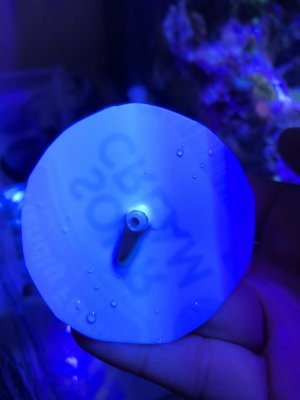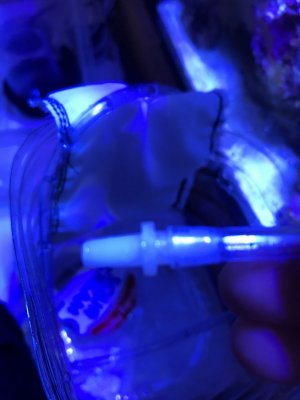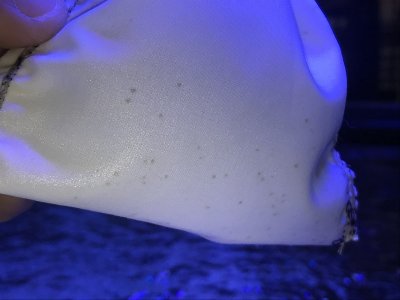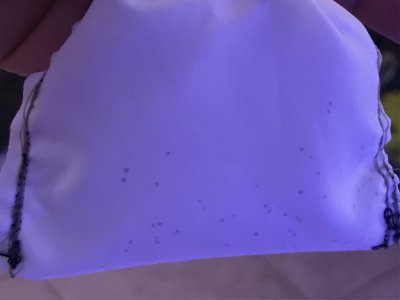Hi everyone. I found this forum on Google while trying to search for info and pictures to try and identify what is going on in my saltwater tank and am new to this forum. So here is where I am (hope you have a large coffee or drink to get you thru this book I am about to give you).
Main Tank:
I took over someone’s 29 gallon Biocube, which had been established for approximately 10 years. The tank had only 1 coral (Green Cinnamon Palythoa) and a Pygmy Angelfish, Clarkii Clownfish, and a Serpent Starfish. Upon quickly transferring to my home, I was able to set back up the reef and replace most of the water and add fresh RedSea saltwater to perform a water change. Well, during the next 3-4 weeks, the water was in balance and I began adding tiny corals to the reef (without performing dips of any kind) and then added a Bengaii Cardinal Fish, and then a Green Mandarin (without doing quarantine). It didn’t take but 3-4 more weeks and the Clarkii Clownfish started resting on the Rhodactis Mushroom and then bashing himself against the corals. I noticed one single dot on the edge of his side fin. After research online, I saw all the info about dipping and quarantine and realized I just made a huge mistake! In the meantime, the starfish had been hidden for 4 days and didn’t come out for frozen spot feeding. So, the reef was taken apart, the fish were removed to put into the QT’s described below (and the starfish was no where in sight and I never found a single spec of bone or shell). To date, I have the Main Tank going thru it’s 76 days of fallow to try to rid any parasites or diseases. However, I have had the awesome experience of diatoms, red stringy dinoflagellates, green hair algae, and briopsis. I have also had hydroid jellyfish (these are almost all gone by dying off) and am now seeing what looks like acoel flatworms, and gill flukes. I used a portable WiFi microscope to take photos of the new creatures I am seeing while in fallow and am puzzled how the possible gill flukes are in existence after 2 months of fallow!! I am also seeing some other creature that looks like an eyeball shape that has 2 whiskers and tiny legs (almost like an ant). Anyhow, I am currently 1 week in on a Fluconazole treatment to remove the green hair algae and briopsis (protein skimmer remove fir first 5 days. Carbon out the entire time and is still out until the 14 day mark). It wiped out the green hair algae and briopsis already since there was hardly any. Any idea what these 3 creatures are and opinions on if I should use PraziPro or FlatwormExit in my Main Tank with all of my corals (I have Softies, LPS, and SPS).
I also have 2 Mexican Turbo Snails, 5 Astrea Snails, a Yellow Sea Cucumber, about 5-6 Micro Starfish, and 1 Feather Duster in my Main Tank.
Mandarin Quarantine:
The Mandarin looked fine and was eating well. Seeing online that the Green Mandarin would have possible reaction to the copper, I set up a 2nd QT for the mandarin (which I have spent almost $1500 in copepods to dose twice daily to keep it well fed!) In week 3, I added a single dose of PraziPro as a preventive for flukes, even though I saw online they tend to be disease resistant.
Fish Quarantine:
After 3 days of being in QT and more Google research, I bought SeaChem Cupramine to begin copper treatment for what I thought might be Ich. I started by raising the copper slowly until I reached the 0.50 level (checking using a Salifert Cu test kit). At 2 weeks in, my local fish store said the white dot (I showed them a video) was Flukes and not Ich. So I added PraziPro to the copper treatment. The fish took well as I raised it and then I kept the copper levels at 0.50 for 4 weeks. Towards the end, I I then noticed the Pygmy Angelfish began looking gray on the skin and the Clarkii Clownfish letting out white stringy poop. My local fish store recommended using Melafix for treatment of a possible bacterial infection and internal worms but said I need to remove both medications before starting Melafix. I did the Melafix treatment for 8 days then began water changes to remove the Melafix. Since the Pygmy Angel was still gray and the Clarkii Clownfish was still scratching and sitting on the bottom, I started API General Cure using the two 48 hour doses on the package. I then did water changes to remove the General Cure slowly. After about 5-6 days, the Clarkii Clown did not let out anymore white stringy poop, but was still scratching and sitting on the bottom. The Pygmy Angelfish is still gray but not as gray as before). I decided to re-do the API General Cure again. Today is day 2, and no change yet except the Clarkii Clown is swimming a bit more.
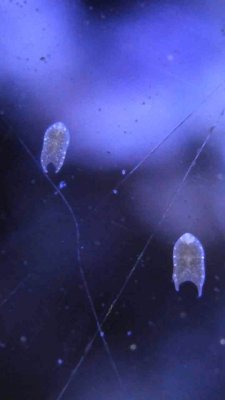
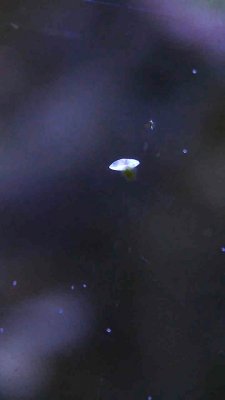
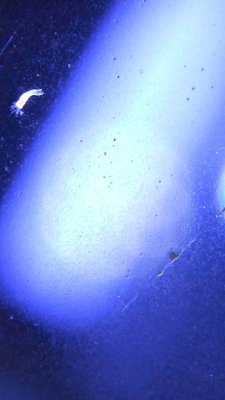
Main Tank:
I took over someone’s 29 gallon Biocube, which had been established for approximately 10 years. The tank had only 1 coral (Green Cinnamon Palythoa) and a Pygmy Angelfish, Clarkii Clownfish, and a Serpent Starfish. Upon quickly transferring to my home, I was able to set back up the reef and replace most of the water and add fresh RedSea saltwater to perform a water change. Well, during the next 3-4 weeks, the water was in balance and I began adding tiny corals to the reef (without performing dips of any kind) and then added a Bengaii Cardinal Fish, and then a Green Mandarin (without doing quarantine). It didn’t take but 3-4 more weeks and the Clarkii Clownfish started resting on the Rhodactis Mushroom and then bashing himself against the corals. I noticed one single dot on the edge of his side fin. After research online, I saw all the info about dipping and quarantine and realized I just made a huge mistake! In the meantime, the starfish had been hidden for 4 days and didn’t come out for frozen spot feeding. So, the reef was taken apart, the fish were removed to put into the QT’s described below (and the starfish was no where in sight and I never found a single spec of bone or shell). To date, I have the Main Tank going thru it’s 76 days of fallow to try to rid any parasites or diseases. However, I have had the awesome experience of diatoms, red stringy dinoflagellates, green hair algae, and briopsis. I have also had hydroid jellyfish (these are almost all gone by dying off) and am now seeing what looks like acoel flatworms, and gill flukes. I used a portable WiFi microscope to take photos of the new creatures I am seeing while in fallow and am puzzled how the possible gill flukes are in existence after 2 months of fallow!! I am also seeing some other creature that looks like an eyeball shape that has 2 whiskers and tiny legs (almost like an ant). Anyhow, I am currently 1 week in on a Fluconazole treatment to remove the green hair algae and briopsis (protein skimmer remove fir first 5 days. Carbon out the entire time and is still out until the 14 day mark). It wiped out the green hair algae and briopsis already since there was hardly any. Any idea what these 3 creatures are and opinions on if I should use PraziPro or FlatwormExit in my Main Tank with all of my corals (I have Softies, LPS, and SPS).
I also have 2 Mexican Turbo Snails, 5 Astrea Snails, a Yellow Sea Cucumber, about 5-6 Micro Starfish, and 1 Feather Duster in my Main Tank.
Mandarin Quarantine:
The Mandarin looked fine and was eating well. Seeing online that the Green Mandarin would have possible reaction to the copper, I set up a 2nd QT for the mandarin (which I have spent almost $1500 in copepods to dose twice daily to keep it well fed!) In week 3, I added a single dose of PraziPro as a preventive for flukes, even though I saw online they tend to be disease resistant.
Fish Quarantine:
After 3 days of being in QT and more Google research, I bought SeaChem Cupramine to begin copper treatment for what I thought might be Ich. I started by raising the copper slowly until I reached the 0.50 level (checking using a Salifert Cu test kit). At 2 weeks in, my local fish store said the white dot (I showed them a video) was Flukes and not Ich. So I added PraziPro to the copper treatment. The fish took well as I raised it and then I kept the copper levels at 0.50 for 4 weeks. Towards the end, I I then noticed the Pygmy Angelfish began looking gray on the skin and the Clarkii Clownfish letting out white stringy poop. My local fish store recommended using Melafix for treatment of a possible bacterial infection and internal worms but said I need to remove both medications before starting Melafix. I did the Melafix treatment for 8 days then began water changes to remove the Melafix. Since the Pygmy Angel was still gray and the Clarkii Clownfish was still scratching and sitting on the bottom, I started API General Cure using the two 48 hour doses on the package. I then did water changes to remove the General Cure slowly. After about 5-6 days, the Clarkii Clown did not let out anymore white stringy poop, but was still scratching and sitting on the bottom. The Pygmy Angelfish is still gray but not as gray as before). I decided to re-do the API General Cure again. Today is day 2, and no change yet except the Clarkii Clown is swimming a bit more.











